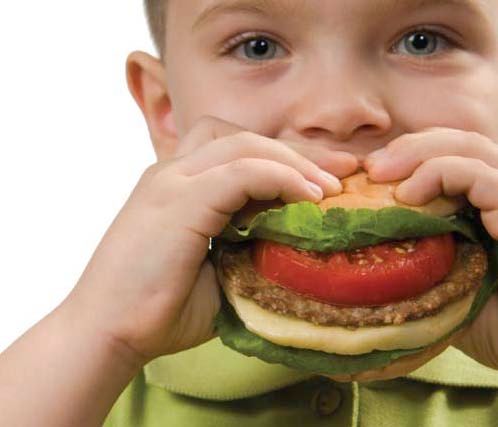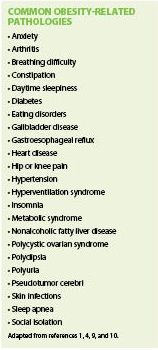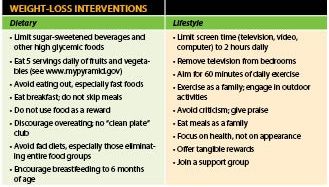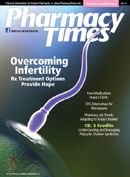Publication
Article
Pharmacy Times
Patient Counseling: Childhood and Adolescent Obesity-A Growing Epidemic
Author(s):
Childhood/adolescent obesity rates continue to grow, and unhealthy diet and physical inactivity are 2 main causes. Counseling these young patients and their families requires sensitivity.
Childhood/adolescent obesity rates continue to grow, and unhealthy diet and physical inactivity are 2 main causes. Counseling these young patients and their families requires sensitivity.

Childhood/adolescent obesity has more than tripled over 30 years. Recent data (2003-2004) found 13.9% of children aged 2 to 5, 18.8% of those aged 6 to 11, and 17.4% of those aged 12 to 17 were obese, having a body mass index (BMI) ≥95th percentile.1 Updated estimates put childhood/adolescent obesity rates even higher—between 16% and 33%.2,3
To eliminate confusion in differentiating overweight from obesity, the American Academy of Pediatrics recommends the following criteria: normal weight (BMI, 5th-84th percentiles); overweight (BMI, 85th-94th percentiles); obese (BMI, 95th- 98th percentiles); and severely obese (BMI, ≥99th percentile).4
CAUSES
Genetic factors, medications, and several endocrine/developmental disorders are associated with weight gain, but are less common. Gene mutations, for example, account for <10% of cases.1 Genetic predisposition may account for up to one third of cases.1 Race and ethnicity are also operative, especially for Mexican American men (22% prevalence) and African American women (24% prevalence). 5
Regardless, environmental causes— excessive television watching, poor parental education, low socioeconomic level, maternal overweight, high weight gain before age 2, high birth weight, formula feeding, maternal smoking during pregnancy, and low meal frequency—are strongest influences.6,7 If one parent is obese, the child has a 50% chance of being obese; if both parents are obese, the percentage climbs to 80%.3 Social factors, such as endless food advertisements, also contribute to obesity.8 Two risk factors, however, are especially prominent: unhealthy diet and physical inactivity.
Consider the following about children:
• Nearly one third eat fast food daily.
• 65% are considered sedentary.
• 25% spend more than 3 hours daily in front of a television or computer.
• 34% drink at least 1 can of sugarladen beverage daily.5,9

MORBIDITY
Childhood/adolescent obesity is associated with over 40 disorders (Sidebar).10 Approximately 60% of obese children aged 5 to 10 years have at least one cardiovascular risk factor, such as elevated cholesterol, elevated blood pressure, or type 2 diabetes; 25% have 2 or more risk factors.5 Pediatric type 2 diabetes was uncommon prior to 1990; now, it accounts for nearly 50% of new diabetes cases.11
Psychological consequences, like anxiety or depression, can be severe. Children with weight problems are often socially isolated and bullied, and self-esteem suffers. Some psychological factors may themselves be risk factors—low selfesteem and depression predict unhealthy eating habits, especially for females.2
TREATMENT
The American Medical Association recommends 4 stages for treatment: stage 1—prevention (adopting a healthy lifestyle to prevent obesity or additional weight gain); stage 2—structured weight management (diet and exercise); stage 3—comprehensive multidisciplinary intervention (eg, physician, dietitian, and an exercise specialist); stage 4—tertiary care (treating obesity-related pathology, including the use of medications and surgery).11
DIETARY AND LIFESTYLE CHANGES
Total calorie restriction coupled with physical activity is fundamental to weight loss. The Table highlights effective dietary and lifestyle interventions. Weight loss need not be great to see improvement; a 5% weight loss reduces insulin and triglycerides.1

PHARMACOTHERAPY
Medications are most effective with diet and exercise and result in modest weight loss (approximately 3 kg or 5%-8% of baseline).4,10 Medications are not recommended for young children because of unknown risk profile.1 Sibutramine (Meridia) is a serotonin reuptake inhibitor, which is approved by the FDA for those 16 years of age and older. One study reports an average weight loss of 14 lb for those treated with sibutramine, compared with an average decrease of 4 lb for placebo.12 Side effects include increased blood pressure and heart rate, dry mouth, constipation, and insomnia.10
Orlistat 120 mg (Xenical), approved for those aged 12 years and older, blocks fat absorption up to 30% by inhibiting intestinal lipase. Side effects include steatorrhea with high-fat meals and decreases in serum levels of fat-soluble vitamins.10 A weaker OTC dose (60 mg) is marketed under the name Alli.
SURGERY
Bariatric surgery can be highly successful in adolescents. Experts recommend considering surgery only for adolescents (at least 13 and 15 years old for females and males, respectively) classified as severely obese who have tried unsuccessfully to lose weight over a 6-month period. Additionally, candidates must present with serious weight-related health problems (eg, type 2 diabetes, heart disease, functional impairments). Patients receive extensive assessment and counseling prior to the procedure.13 The American Society of Plastic Surgeons does not recommend liposuction for childhood obesity.14
PSYCHOLOGICAL
Treatment goals often include more than weight loss. Psychological counseling is an important treatment component. Along with treating depression and low self-esteem, sessions may also focus on eating behavior and attitudes about eating.
PHARMACIST COUNSELING
Effective counseling begins with the recognition that society often blames the patient (or parent); addressing obesity requires sensitivity. Avoid the stigmatizing terms “fat” or “obese.” Approach the topic with nonthreatening statements, often in the form of questions. Rephrase, “Your child is obese,” to “Your child seems to put on weight easily. What do you think?” Address other issues similarly, “Might he watch too much television?” List alternatives in a way that elicits a response: “Which one of these might be worth trying?”
Individual interventions are less successful when siblings or mother are overweight. 15 Family eating habits are directly linked to children’s weight gain, so treatment involves the entire household. Parents must be motivated to change their own behavior. Many parents fail to intervene, mistakenly believing children outgrow “chubbiness.” Childhood weight tends to be permanent—80% of obese children aged 10 to 13 develop into obese adults.3 Emphasize that children tend to have a more long-lasting response to weight-loss programs than adults.10
Avoid recommending fad diets; as many as 80% of children using unsupervised diets suffer from medical problems linked to these diets.10 Dietary supplements and herbal remedies are likewise ineffective. An excellent patient resource for healthy diets can be found at www.mypyramid.gov.
Finally, examine the potential role of current medications. Medications associated with weight gain include corticosteroids, progestins, valproate, cyproheptadine, mirtazapine, and atypical antipsychotics.1 Always end counseling sessions by eliciting the patient’s understanding. Attempt to get a commitment for change; offer guidelines for a weightloss plan.
FINAL THOUGHT
Obesity should be approached as a chronic condition requiring ongoing monitoring. Losing weight can be difficult, and many become easily discouraged. Ongoing reinforcement and encouragement are likewise important interventions.
Dr. Zanni is a psychologist and health systems consultant based in Alexandria, Virginia.
References
1. Bradford NF. Overweight and obesity in children and adolescents. Prim Care. 2009;36(2):319-339.
2. Neumark-Sztainer D, Wall M, Story M, Sherwood NE. Five-year longitudinal predictive factors for disordered eating in a population-based sample of overweight adolescents: implications for prevention and treatment. Int J Eat Disord. 2009;42(7):664-672.
3. Obesity in children and teens. American Academy of Child and Adolescent Psychiatry Web site. www.aacap.org/c /root/facts_for_families/obesity_in_children_and_teens. Accessed November 11, 2009.
4. Barlow SE; Expert Committee. Expert committee recommendations regarding the prevention, assessment, and treatment of child and adolescent overweight and obesity: summary report. Pediatrics. 2007;120 Suppl 4:S164-S192.
5. Childhood obesity statistics and facts. National Association of Children's Hospitals and Related Institutions Web site. www.childrenshospitals.net/AM/Template.cfm?Section=Search3&template=/CM/HTMLDisplay.cfm&ContentID=51332. Accessed November 10, 2009.
6. Rowland K, Wallace R. Clinical inquiries: Which factors increase the risk of an infant becoming an overweight child? J Fam Pract. 2009;58(7):383-384. Review.
7. Toschke A, von Kries R, Beyerien A, Ruckinger S. Risk factors for childhood obesity: shift of the entire BMI distribution vs. shift of the upper tail only in a cross sectional study. BMC Public Health. 2008;8:115.
8. Ben-Sefer E, Ben-Natan M, Ehrenfeld M. Childhood obesity: current literature, policy and implications for practice. Int Nurs Rev. 2009;56(2):166-173.
9. Expert committee recommendations on the assessment, prevention and treatment of child and adolescent overweight and obesity-2007. Childhood Obesity Action Network. www.gaaap.org/Newsletter%20pag /COANImplementationGuide62607FINAL.pdf. Accessed November 11, 2009.
10. Hoppin A. Assessment and management of childhood and adolescent obesity. http://cme.medscape.com/viewarticle/481633. Accessed November 16, 2009.
11. Barclay L, Murata P. AMA recommends 4-stage approach to treatment of childhood obesity. http://cme.medscape.com/viewarticle/577665. Accessed November 10, 2009.
12. Berkowitz RI, Fujioka K, Daniels SR, et al; Sibutramine Adolescent Study Group. Effects of sibutramine treatment in obese adolescents: a randomized trial. Ann Intern Med. 2006;145(2):81-90.
13. Bariatric surgery for adolescents. The National Institute of Diabetes and Digestive and Kidney Diseases Web site. http://win.niddk.nih.gov/publications/gastric.htm. Accessed November 11, 2009.
14. Childhood obesity and liposuction are not a good mix, ASPS cautions. Medical News Today Web site. www.medicalnewstoday.com/articles/67141.php. Accessed November 11, 2009.
15. Pott W, Albayrak O, Hebebrand J, Pauli-Pott U. Treating childhood obesity: family background variables and the child's success in a weight-control intervention. Int J Eat Disord. 2009;42(3):284-289.







